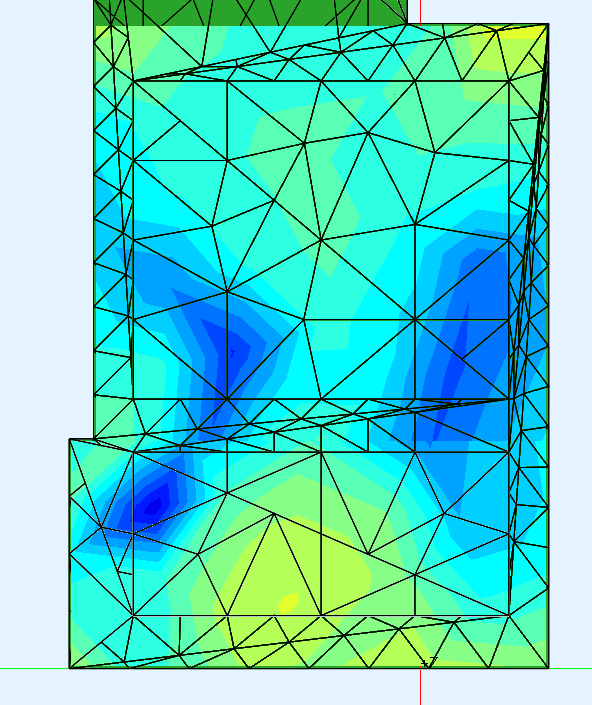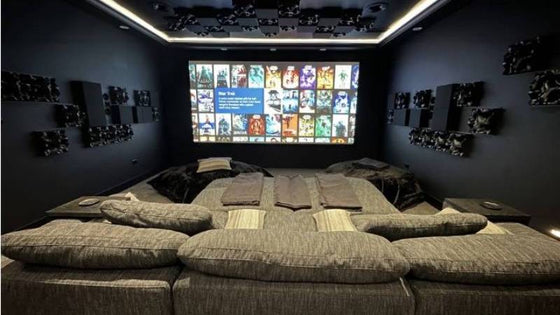Creating a system you love shouldn't be difficult. The Acoustic Frontiers blog is here to help.

The client approached Acoustic Frontiers to create a high performance listening room in the home he had just purchased. The initial plan was to remove the existing floor-to-ceiling cabinets at the front of the room and do a minor remodel in order to fill in some of the openings in the side walls and create a more balanced left / right environments for the speaker system. The client's equipment included Avantgarde Duo Omega G2 speakers, Lamm ML2 amplifiers, a Pass Labs XVR1 crossover and JL Audio Fathom F112 subwoofers. The room needed to function as a high performance stereo listening room as well as a basic home theater with retractable projection screen and a separate set of speakers.

Move in day! Here's the space the client wanted us to transform into an audiophile listening room.
During the remodel, we advised on best location for the opening from the hallway into the room, and also on wall construction. Since the client was aiming for the best results possible in the space, we recommended that he insulate all wall and ceiling cavities and replace existing gypsum board with factory damped drywall. Undamped drywall and uninsulated wall / ceiling cavities resonate strongly at one frequency and multiples thereof, damaging the quality of the audio reproduction - after the bass note from the sound system stops, the walls / ceiling continues to resonate, muddying the sound and reducing articulation and impact. To learn more about damped construction techniques, see our bass optimization blog post.
Speaker / sub / listener position options were modeled, and the best option (in terms of flatness of frequency response) was chosen as the basis for the acoustic treatment design.

Speaker / listener position optimization results.
The modeling revealed that there would be frequency response issues caused by room mode resonances around 27Hz and 70Hz. The 70Hz issue is just below the crossover point of the subs and main speakers, and we could not rely on equalization to fix it since the client did not want to add any EQ to the main left / right signal path, only the subs. 70Hz is also a frequency that is addressable using high quality bass trapping. The 27Hz resonance we would aim to correct using the 'ARO' EQ built into the JL Audio Fathom subwoofers. Optimal locations for pressure-based bass trapping were identified as top of the front wall using our advanced low frequency modeling techniques.

Computer based modeling shows areas of high sound pressure (yellow) and low (blue), allowing best locations for tuned bass trapping to be identified. This simulation was completed at top-of-wall height (additional simulations were run for middle-of-wall and bottom-of-wall).
Our audiophile listening room acoustics design included five large tuned bass traps on the front wall and a custom minimally absorptive side wall diffuser.

Custom side wall absorber / diffusers. These were designed to manage early reflected energy from the Avantgarde horns, and include 1D and 2D scattering as well as hybrid absorption / diffusion.
Hybrid absorber / diffuser panels, specified to reduce the speaker boundary interference cancellation from the front wall, were mounted to roller tracks such that they could be moved to the optimal location for stereo listening, and then rolled back to expose the left / center / right speakers for home theater usage.
We think the room turned out looking great, with the custom side wall acoustic treatment being a particular highlight of the build.


Rear of listening room showing ceiling mounted QRD type diffusers and hybrid absorber / diffusers (large flat panels behind projector).

Custom side wall 1D + 2D hybrid absorber-diffuser panel.
The post-calibration measurements looked good, but JL Audio's ARO did not do what we were hoping in terms of dealing with the 27Hz peak. We advised the client to upgrade to the newer DARO in the v2 Fathom subwoofers, which works better.

Frequency response of both speakers and subs at 1/12th octave resolution after calibration.
Learn how early home theater design, layout, and acoustic treatment improve performance in new home construction.
This media room was intentionally designed to feel like part of the home—not a separate, tech-heavy space. Through careful acoustic planning, equipment integration, and final calibration, we achieved a room that is both beautiful to live in and immersive to experience.
"No other subwoofer system I’ve owned even comes close to what this room delivers. Reaching out to Acoustic Frontiers was one of the best decisions I’ve made—I highly recommend working with them if you want to get the most out of your theater."

Nyal Mellor, Founder, Acoustic Frontiers



Nyal Mellor
Author